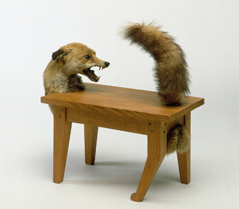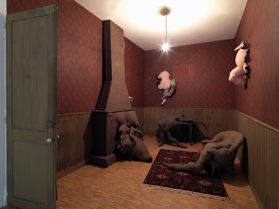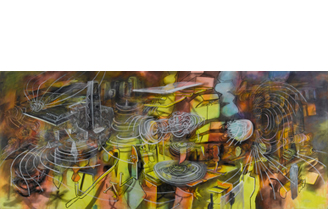Victor Brauner
1903 Piatra Neamt, Romania – 1966 Paris, France
Loup–table (Wolf–table) [1939]/1947
Wood and taxidermied fox
54 x 57 x 28.5cm
Gift of Jacqueline Victor–Brauner 1982
Collection: Musée national d’art moderne, Centre Pompidou, Paris
AM 1974–27
© Collection Centre Pompidou, Dist. RMN /
Philippe Migeat
© Victor Brauner/ADAGP. Licensed by Viscopy, Sydney, 2011
The hybrid creature of Loup–table (Wolf–table) first appeared in two canvases painted by Victor Brauner in 1939. Eight years later, the creature emerged in three dimensions as this sculpture–object. Loup–table was most probably executed at the suggestion of André Breton, for inclusion in the exhibition ‘Le Surréalisme en 1947’, held at Galerie Maeght, Paris.
Typically surrealist, Loup–table suggests images that are paradoxical and it connotes a number of prevailing fears and desires. The object conflates ideas of domesticity with the savagery of a wild beast. The animal is frozen in a howl, and ‘screaming over its shoulder at death and displaying proudly a bulging scrotum’, as André Breton wrote in his 1946 essay ‘Entre chien et loup’. Seemingly devouring itself, the animal is biting at its own tail in an act of frenzied self–destruction. For Breton, Brauner’s work in the 1930s, and particularly the motif of the wolf–table, was the ‘most lucid testimony’ of the anxiety consuming a Europe on the brink of World War Two.
Dorothea Tanning
b.1910 Galesburg, Illinois, USA
Chambre 202, Hôtel du Pavot
(Room 202, Hôtel du Pavot) 1970
Wood, fabric, wool, paper, paint, carpet,
light bulbs, wallpaper, imitation wood panel
Installed dimensions variable
Purchased 1977
Collection: Musée national d'art modern, Centre Pompidou, Paris
AM 1977-204
© Collection Centre Pompidou, Dist. RMN /
Georges Meguerditchian
© Dorothea Tanning/ADAGP.
Licensed by Viscopy, Sydney, 2011
Following its first presentation as part of Dorothea Tanning’s retrospective exhibition in Paris in 1974, Chambre 202, Hôtel du Pavot was acquired for the inaugural installation of the Musée national d’art moderne, Centre Pompidou, in 1977. Within the recreated room of a seedy, old–fashioned hotel, decorated with floral wallpaper and fake wood panelling, four previously separate sculptures made from cloth and stuffed with wool are united. These are: Hôtel du Pavot – two pink crepe figures mounted on the walls; Revelation or The end of the month – a tweed figure merging into an armchair; Time and place – a chimney breast bulging with monstrous forms; and Table tragique (Tragic table), with its swooning, prone figure.
Tanning first encountered Surrealism at the 1936 exhibition ‘Fantastic Art, Dada and Surrealism’, held at the Museum of Modern Art, New York. Soon after, Tanning began her dream paintings, such as Un tableau tres heureux 1947 (seen elsewhere in this exhibition). The domestic language of Tanning’s later works, with their use of wallpaper and fabric, seems the physical realisation of scenes Tanning evoked much earlier in prose works. For example, in her 1942 text ‘Blind date’, she wrote:
It must have been a very bleak winter that year. I have no recollection of the weather, only the marvellous and relentless order in which everything occurred. It was the time that the sewing machine broke loose; nothing could have been more inopportune or diabolically calculated …
Tanning’s writing, paintings and sculptures describe unnerving events, often inspired by her dreams, often taking place in domestic interiors (the sewing machine, Surrealism’s leitmotif, always invoking femininity). She once remarked that, during her small–town Midwestern childhood, ‘nothing happened but the wallpaper’.
Roberto Matta (Roberto Antonio Sebastián Matta Echaurren)
1911 Santiago, Chile – 2002 Civitavecchia, Italy
Trans–apparence du Verbe (The Trans-appearance of Language) 1977–80
Oil on canvas
307 x 725cm
Dation 2007
Collection: Musée national d’art modern, Centre Pompidou, Paris
AM 2008–15
© Collection Centre Pompidou, Dist. RMN /
Philippe Migeat
© Matta/ADAGP.
Licensed by Viscopy, Sydney, 2011
Roberto Matta studied architecture in Chile before moving to Europe, in 1933, to work with the Swiss–born architect Le Corbusier. In 1934, Matta showed André Breton a number of his drawings, and he was subsequently invited to join the surrealists and participate in the 1938 exhibition ‘Exposition internationale du surréalisme’. The same year, he began his first series of paintings, which he called ‘psychological morphologies’ and ‘inscapes’ – a blending of ‘interior’ and ‘landscapes’.
In 1939, Matta moved to New York, where he joined the artistic milieu of other exiled surrealists, as well as Jackson Pollock, Robert Motherwell and Arshile Gorky. Mexican mural painters David Siqueiros and Diego Rivera, who worked in New York in the late 1930s, influenced Matta to paint on a larger scale, anticipating the monumental canvases that would become a trademark for the Abstract Expressionists. In 1939, Matta also encountered Marcel Duchamp, as well as many of Duchamp’s works, in the Connecticut home of the artist and collector Katherine Dreier – including The Bride Stripped Bare by Her Bachelors, Even(The Large Glass) 1915–23.
Although painted some 40 years after that first encounter, Trans–apparence du Verbe continues Matta’s dialogue with Duchamp’s enigmatic and conceptual work. In French, the painting’s title sounds like transparence deverre, meaning ‘transparent glass’. Many of the curvilinear white shapes on the painting’s surface echo the forms Duchamp painted on glass in his original work. For Matta, Duchamp’s work was particularly significant for the priority placed on the viewer’s participation in the work through a process of ‘dynamic perception’. In an essay Matta co–wrote with Dreier, in 1943, called ‘Duchamp’s glass’ – which is one of the earliest critical essays to discuss The Large Glass – they observed: ‘The image is not a thing. It is an act which must be completed by the spectator’.
Please note: The videos featured in this virtual tour are available to Australian audiences only.
1946–1966 LAST FLAMES
Despite its internationalisation during the war years, Surrealism’s influence and energy began to wane in the 1950s and 1960s. This was due partly to the rise of other art forms such as Abstract Expressionism and Pop art in the United Sates, which responded in new ways to the changed political, social and technological landscapes of postwar life. For many of its original adherents, however, Surrealism’s relevance continued unabated, and developments in popular culture and contemporary art were absorbed into their field of inquiry.
The late 1940s witnessed some of the most vibrant moments in the history of the movement, in particular the exhibition ‘Le Surréalisme en 1947’, at the Galerie Maeght in Paris, which André Breton organised with Marcel Duchamp. The exhibition showed works by more than 100 artists, including, Hans Bellmer, Victor Brauner, Max Ernst, Wilfredo Lam, Jaqueline Lamba, Roberto Matta, Joan Miró, Isamu Noguchi, Francis Picabia, Man Ray, Yves Tanguy and Dorothea Tanning.
In the 1950s in France, some interpreted the experiments with abstract painting by artists such as Hantal as being derived from Surrealism. The art critic Charles Estienne has been credited as coining the term ‘Art Informel’, denoting an art that avoids form or, rather, seeks formlessness and the dissolution of rigid, structural means of representation.
Although the ‘official’ surrealist movement ceased in 1966, with the death of its founder André Breton, its influence continued. Arguably, this was due to the longevity and creative energy of some of its early practitioners, including Matta, Miró and Tanning. However, it was also due to the fact that ‘Surrealism’ had become expansive as a concept – it was no longer restricted to a singular aesthetic style or definition. Today, Surrealism continues to provide an entry point for aesthetic and poetic inquiry, and the expression of the unconscious.



